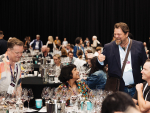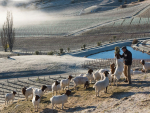Haere Ra 2025: Whakatū, Nelson
Abel’s Mark McGill, a Chardonnay champion of the Moutere Valley, looks back at a challenging season and “stellar” vintage.
Abel flew through its spray programme – quite literally – in the lead up to vintage 2024.
Using a drone for spring spraying and autumn fertilisation helped protect the Moutere wine company’s clay soils, while saving time and emissions, says Mark McGill, who owns and runs Abel, a Chardonnay and cider producer, with his wife Sophie. “It means I can actually spend more time in the vines doing canopy management rather than sitting in a vehicle.” Spray jobs that once took him hours can be done in 15 minutes. “If I can free up time to spend in my vines, why not?”
Mark and Sophie want a tractorless farm, orchard and vineyard, to reduce costs and soil compaction. While Mark still sprayed other blocks with his mule this season, the drones could mean that in the future Abel’s rows are impacted by little more than boots and hooves, enabling greater soil carbon sequestration, and enhanced water and vine infiltration, while also dramatically reducing diesel use.
While the drone sprays from above, changing the angle of penetration, he’s confident of the coverage, noting that downwash from the drone helps open up the canopy. “We trialled it on two different vineyards – our own vineyard with young vines and not a lot of canopy, and an old one with a lot of canopy, in two different parts of the region. So we got a good understanding of what’s possible… we’re certainly going to do more next year.”
Scott Horgan at Airbourne Solutions has been working with the likes of Abel in Nelson, Bilancia in Hawke’s Bay, and Felton Road in Bannockburn, and says drone spraying addresses challenges like narrow rows, cover crops, emissions reduction targets, and impractical spray operations. Some of the companies are buying their own drones, while others, like Abel, are using local contractors. Several of the viticulturists he works with are planning to tailor their canopy management to the drone application, Scott adds. While the vineyards he’s worked with so far are small in scale, he believes drones would be suited to any vineyard.

The end of the year is fast approaching, so here are some thoughts on a few of the significant developments…

OPINION: When I moved to Marlborough two decades ago, I found countless lines of tidy vines, neatly mowed and carefully…
The large 2025 harvest will exacerbate the wine industry's "lingering" supply from recent vintages, New Zealand Winegrowers Chief Executive Philip…
If you find a new consumer in a developed wine market, you are taking them from someone else, says Blank…
OPINION: Sauvignon Blanc was famously introduced to New Zealand by Ross Spence of Matua Valley, and then serendipitously planted in…